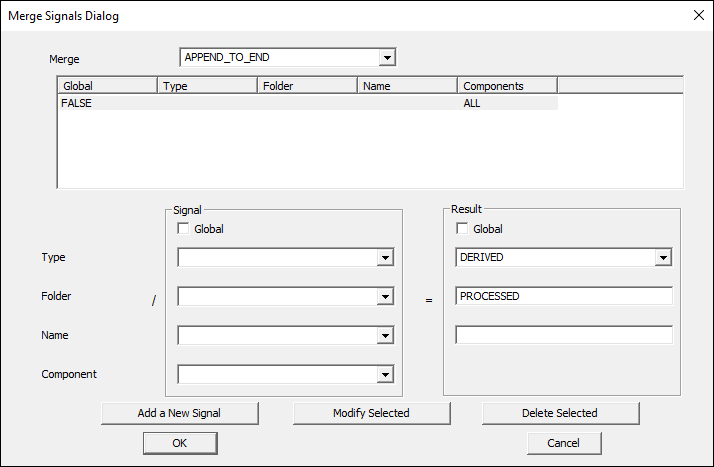Table of Contents
Merge Data
This command merges data from multiple signals into a single signal in one of two ways:
- either via APPEND_TO_END, appending one signal to the end of another signal, or
- via MERGE_AS_NEW_COMPONENTS, treating each original signal as a component of the new signal.
Merge_Data \SIGNAL_TYPES= \SIGNAL_FOLDER= \SIGNAL_NAMES= !\COMPONENT_SEQUENCE= !\RESULT_TYPES=DERIVED !\RESULT_FOLDERS=PROCESSED !\RESULT_NAME= !\MERGE_TYPE=APPEND_TO_END !\IGNORE_MISSING_SIGNALS=FALSE !\PRE_CLEAR_RESULT_SIGNAL=FALSE ;
Parameters
COMPONENT_SEQUENCE: if empty, all components of the signals will be used
MERGE_TYPE: APPEND_TO_END or MERGE_AS_NEW_COMPONENTS
- APPEND_TO_END append one signal to the end of another signal
- MERGE_AS_NEW_COMPONENTS treat each original signal as a component of the new signal
IGNORE_MISSING_SIGNALS:
PRE_CLEAR_RESULT_SIGNAL: Will delete the resulting signal prior to beginning
Examples
Below are some examples for using the Merge_Data command demonstrating both types of merges.
Simple Example
The command below will create a vector named Vector from 3 analog signals. This is an example of merging 3 signals into one signal.
Merge_Data /SIGNAL_NAMES=Analog1+Analog2+Analog3 /SIGNAL_TYPES=ANALOG+ANALOG+ANALOG /SIGNAL_FOLDER=ORIGINAL+ORIGINAL+ORIGINAL /SIGNAL_COMPONENTS=0+0+0 /RESULT_NAME=Vector /RESULT_TYPE=DERIVED /RESULT_FOLDER=PROCESSED /MERGE_TYPE=MERGE_AS_NEW_COMPONENTS ;
Create Global List of all Instances
Select_Active_File /FILE_NAME=ALL_FILES ; Merge_Data /SIGNAL_TYPES=METRIC /SIGNAL_FOLDER=PROCESSED /SIGNAL_NAMES=GLOBAL::List_of_Instances+L_Ankle_Stiffness /COMPONENT_SEQUENCE=ALL /RESULT_TYPES=METRIC ! /RESULT_FOLDERS=PROCESSED /RESULT_NAME=GLOBAL::List_of_Instances ! /MERGE_TYPE=APPEND_TO_END /IGNORE_MISSING_SIGNALS=FALSE /PRE_CLEAR_RESULT_SIGNAL=TRUE ;
Add a column to a metric
Another example adds an indexing column to a metric (single values). This will allow the metric to be graphed.
Merge for ASCII export
The example found on Exporting Concatenated Metric Signals will concatenate metrics signals prior to exporting to an ASCII file.
When exporting, all signals are exported to separate columns in the exported file. For metric signals (e.g. signals with only one or two entries/frames) this can be inconvenient. It is not possible to concatenate the signals in the export command, but it is possible to concatenate the signals explicitly before export.
